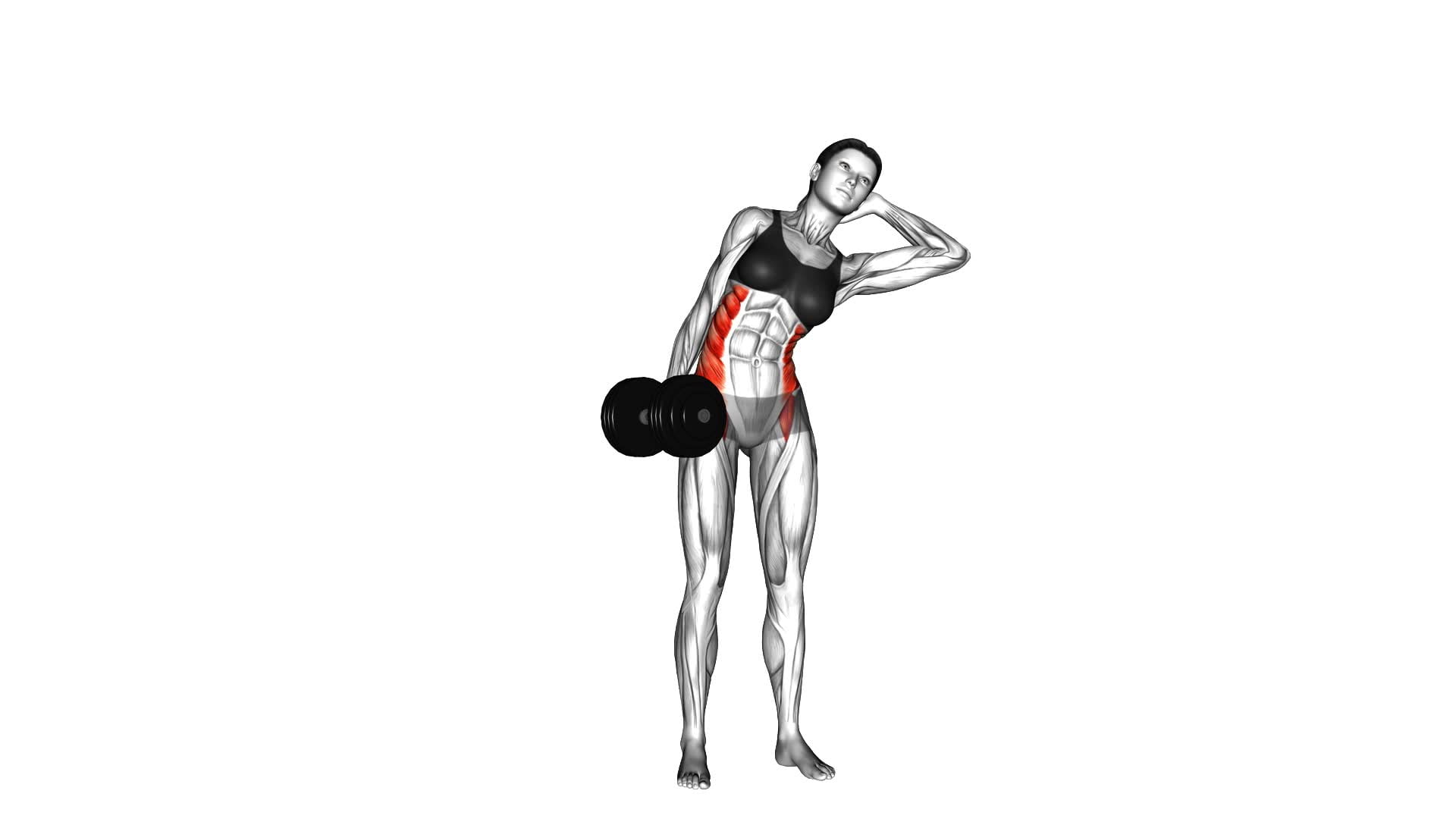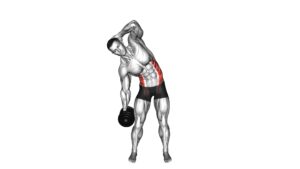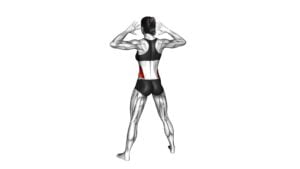Dumbbell Side Bend (female) – Video Exercise Guide & Tips

Are you looking to tone and strengthen your core?
Watch This Exercise Video
The dumbbell side bend is a great exercise for targeting your obliques and improving your overall stability.
In this video exercise guide, we'll show you the proper form and provide tips on how to maximize your results.
Avoid common mistakes and challenge yourself with variations.
Incorporate the dumbbell side bend into your workout routine and start seeing the results you've been working towards.
Let's get started!
Key Takeaways
- Targets and strengthens oblique muscles
- Improves core stability and supports the spine
- Enhances posture and reduces the risk of back pain
- Enhances athletic performance
Benefits of the Dumbbell Side Bend
To fully understand the benefits of the Dumbbell Side Bend, it's important for you to know how this exercise targets and strengthens your oblique muscles. The obliques are the muscles located on the sides of your abdomen, and they play a crucial role in stabilizing your core and supporting your spine. By engaging in oblique exercises like the Dumbbell Side Bend, you can enhance your overall core strength and stability.
One of the key benefits of oblique exercises, including the Dumbbell Side Bend, is improving your posture. Strong oblique muscles help to maintain proper alignment of your spine, reducing the risk of developing back pain. Additionally, these exercises can help to enhance your athletic performance, as strong oblique muscles provide stability and power for movements such as twisting, bending, and rotating.
In order to maximize the benefits of the Dumbbell Side Bend, it's important to practice proper breathing technique. As you perform the exercise, exhale deeply as you lower the dumbbell towards your hip, and inhale as you raise it back up. This controlled breathing not only helps to engage your oblique muscles more effectively, but also promotes relaxation and focus during the exercise.
Now that you understand the benefits of the Dumbbell Side Bend and the importance of proper breathing technique, let's move on to discussing the proper form for this exercise.
Proper Form for the Dumbbell Side Bend
Now that you know the benefits of the Dumbbell Side Bend and how it targets your oblique muscles, let's delve into the proper form for this exercise. Proper form is crucial to ensure that you're effectively targeting your obliques while minimizing the risk of injury.
To begin, stand with your feet shoulder-width apart and hold a dumbbell in one hand. Place your other hand on your hip for stability. Keep your back straight and engage your core to maintain a stable position throughout the exercise.
Now, slowly lower the dumbbell towards the side of your body, bending at the waist. Be sure to keep your shoulders level and avoid leaning forward or backward. Lower the weight as far as you can comfortably go, feeling a stretch in your oblique muscles.
Next, slowly return to the starting position by using your oblique muscles to pull yourself back up. Repeat the movement for the desired number of repetitions and then switch sides.
Remember, core stability is important for this exercise. By engaging your core throughout the movement, you won't only target your obliques but also improve your overall core strength and stability.
If you find the Dumbbell Side Bend challenging or want to switch up your routine, there are alternative exercises that also target your oblique muscles. These include exercises like Russian twists, bicycle crunches, and side plank rotations.
Tips for Maximizing Your Results
To maximize your results, follow these tips:
- Use proper form: Ensuring that you maintain proper form throughout the dumbbell side bend exercise is crucial for maximizing results. Keep your back straight, engage your core, and avoid using momentum to swing the dumbbell. This will target the muscles effectively and reduce the risk of injury.
- Choose the right weight: Selecting the appropriate weight for your fitness level is essential. Start with a lighter weight and gradually increase as you become stronger. Using a weight that's too heavy may compromise your form and hinder your progress.
- Focus on controlled movements: Slow and controlled movements are key to maximizing your results. Avoid rushing through the exercise and instead, concentrate on feeling the targeted muscles working with each repetition. This will enhance muscle activation and help you achieve better results.
- Incorporate variations: To keep your workouts challenging and avoid plateauing, consider incorporating different variations of the dumbbell side bend. This could include performing the exercise on an incline bench or adding a twist at the end of each repetition. These variations will engage different muscle fibers and help you achieve more comprehensive results.
Common Mistakes to Avoid
To avoid common mistakes during the dumbbell side bend exercise, it's essential to understand the dangers of incorrect form and the importance of proper technique. Incorrect form can lead to injuries, such as strained muscles or back pain.
Incorrect Form Dangers
Avoid these three common mistakes when performing the dumbbell side bend exercise to prevent potential injuries and the dangers of incorrect form:
- Using a weight that's too heavy: Using a weight that's too heavy can put excessive strain on your lower back and increase the risk of injury. Start with a lighter weight and gradually increase as your strength improves.
- Leaning forward or backward: It's important to maintain proper alignment during the exercise. Avoid leaning forward or backward, as this can place unnecessary stress on your spine.
- Using momentum: Avoid using momentum to lift the weight. Instead, focus on using your obliques to perform the movement in a controlled manner.
- Not engaging the core: Your core muscles play a crucial role in stabilizing your body during the exercise. Make sure to engage your core muscles throughout the movement to prevent strain on your back.
Proper Technique Importance
Make sure you maintain proper technique while performing the dumbbell side bend exercise to maximize its effectiveness and minimize the risk of injury. The importance of technique can't be overstated when it comes to any exercise, including the dumbbell side bend. By using the correct technique, you engage the targeted muscles more efficiently and effectively, leading to better results.
Additionally, proper technique helps to prevent strain or injury to your back, shoulders, and neck. One common mistake to avoid is using too much weight, which can cause your form to suffer and increase the risk of injury. Another mistake is leaning forward or backward, instead of maintaining a straight posture throughout the exercise.
Variations to Challenge Yourself
As you progress in your dumbbell side bend exercises, you can further challenge yourself by incorporating variations. These challenging modifications and advanced side bend variations will take your workout to the next level and help you achieve even greater results.
Here are some variations to consider:
- One-arm dumbbell side bend: Instead of using both dumbbells, hold only one dumbbell in one hand while performing the side bend. This will require more stability and strength in your core.
- Weighted side plank: Start in a side plank position and hold a dumbbell in your top hand. Lift the dumbbell towards the ceiling as you engage your oblique muscles. This variation not only targets your obliques but also challenges your balance and stability.
- Standing cable side bend: Attach a cable to a low pulley and stand with your side facing the pulley. Hold the handle with one hand and perform the side bend motion. The resistance from the cable will add an extra challenge to the exercise.
- Swiss ball side bend: Sit on a Swiss ball with your feet planted firmly on the ground. Hold a dumbbell in one hand and perform the side bend motion. The instability of the Swiss ball will engage your core muscles even more.
Incorporating these variations into your dumbbell side bend routine will help you continually challenge your muscles and progress towards your fitness goals. Remember to start with lighter weights and gradually increase the resistance as you become more comfortable with each variation.
Incorporating the Dumbbell Side Bend Into Your Workout Routine
To incorporate the dumbbell side bend into your workout routine, it's important to understand the benefits of this exercise.
Side bends target your oblique muscles, helping to strengthen and tone your waistline.
By performing side bends with proper form and technique, you can maximize the effectiveness of the exercise.
Additionally, there are variations of the dumbbell side bend that you can try to challenge yourself at different fitness levels.
Benefits of Side Bends
Incorporate the dumbbell side bend into your workout routine to experience the benefits of side bends. This exercise targets your oblique muscles, helping to strengthen and tone your waistline.
Here are some key benefits of incorporating side bends into your routine:
- Improved core strength: Side bends engage your core muscles, including your obliques, rectus abdominis, and transverse abdominis, helping to improve overall core strength and stability.
- Increased flexibility: Side bends involve a lateral flexion movement, which helps to improve flexibility in your spine and waist.
- Better posture: Strengthening your oblique muscles through side bends can help improve your posture by supporting your spine and promoting proper alignment.
- Enhanced sports performance: Side bends can help improve your performance in sports that involve twisting or rotating movements, such as golf or tennis.
Proper Form and Technique
To properly incorporate the dumbbell side bend into your workout routine, focus on maintaining proper form and technique. This is crucial for maximizing results and avoiding mistakes.
Start by standing upright with your feet shoulder-width apart and holding a dumbbell in one hand. Keep your back straight and engage your core muscles. Slowly bend to the side, lowering the dumbbell towards your knee while keeping your arm extended.
Make sure to avoid twisting or leaning forward as you perform the exercise. Return to the starting position and repeat on the other side.
By maintaining proper form and technique, you can effectively target your oblique muscles and achieve the desired results.
Now, let's move on to exploring variations for different levels.
Variations for Different Levels
Now, let's explore different variations of the dumbbell side bend that you can incorporate into your workout routine to cater to different fitness levels. Here are some options to consider:
- Progression Levels: If you're looking to increase the intensity of the exercise, you can try using heavier dumbbells or adding more repetitions. This will challenge your oblique muscles even more and help you build strength and definition.
- Modifications for Beginners: If you're new to the dumbbell side bend, it's important to start with lighter weights and focus on proper form. You can also try performing the exercise without weights initially to build stability and control before adding the extra resistance.
- Seated Dumbbell Side Bend: Instead of standing, you can perform the side bend exercise while seated on a bench or stability ball. This variation targets the same muscles but provides a different challenge to your core and balance.
- Single Arm Dumbbell Side Bend: To further isolate your oblique muscles, you can perform the exercise with only one arm at a time. This variation adds an additional challenge to your core stability and coordination.
Remember to choose the variation that suits your fitness level and gradually progress as you get stronger.
Frequently Asked Questions
Can the Dumbbell Side Bend Help in Reducing Waistline Fat?
Yes, the dumbbell side bend can help in reducing waistline fat. However, it's important to note that spot reduction can't be achieved through this exercise alone.
To achieve optimal results, it's recommended to combine the dumbbell side bend with other exercises that target the entire core and engage multiple muscle groups. By incorporating a well-rounded workout routine, you can maximize your efforts and work towards a slimmer waistline.
How Heavy Should the Dumbbells Be for Performing the Dumbbell Side Bend?
When performing the dumbbell side bend, it's important to choose the right weight for you. Start with lighter dumbbells to ensure proper form and technique. Gradually increase the weight as you become more comfortable and stronger.
However, it's essential to remember that the dumbbell side bend alone may not directly reduce waistline fat. It can help strengthen and tone your obliques, but a combination of proper nutrition and overall exercise is key for fat loss.
Can the Dumbbell Side Bend Be Performed by Beginners?
Yes, beginners can perform the dumbbell side bend. To ensure proper form and prevent injury, start with lighter dumbbells or no weights at all. Focus on mastering the technique before increasing the weight.
Beginners should also avoid common mistakes like using momentum instead of controlled movements and rounding the back. Remember to engage your core and breathe properly throughout the exercise.
With modifications and practice, you can safely and effectively perform the dumbbell side bend.
Is It Necessary to Perform the Exercise on Both Sides of the Body?
Yes, it's necessary to perform the dumbbell side bend exercise on both sides of the body.
By doing so, you ensure that both sides of your core are engaged and strengthened evenly. This helps to prevent muscle imbalances and promotes better overall stability.
Consistently performing the dumbbell side bend can also lead to improved posture and a more defined waistline.
How Often Should the Dumbbell Side Bend Be Included in a Workout Routine for Maximum Benefits?
For maximum benefits, you should include the dumbbell side bend in your workout routine with the right frequency. This exercise targets your oblique muscles and helps strengthen your core.
To get the most out of it, aim to perform the dumbbell side bend 2-3 times a week, allowing for adequate rest between sessions.
Remember to start with lighter weights and gradually increase as you get stronger. As with any exercise, listen to your body and make modifications as needed.
Conclusion
Incorporating the dumbbell side bend into your workout routine can provide numerous benefits, including improved core strength and stability. By maintaining proper form and avoiding common mistakes, you can maximize your results.
Additionally, challenging yourself with variations of the exercise can help you continue to progress and see improvements. Remember to consult with a professional trainer or instructor to ensure you're performing the dumbbell side bend correctly and safely.

Author
Years ago, the spark of my life’s passion ignited in my mind the moment I stepped into the local gym for the first time. The inaugural bead of perspiration, the initial endeavor, the very first surge of endorphins, and a sense of pride that washed over me post-workout marked the beginning of my deep-seated interest in strength sports, fitness, and sports nutrition. This very curiosity blossomed rapidly into a profound fascination, propelling me to earn a Master’s degree in Physical Education from the Academy of Physical Education in Krakow, followed by a Sports Manager diploma from the Jagiellonian University. My journey of growth led me to gain more specialized qualifications, such as being a certified personal trainer with a focus on sports dietetics, a lifeguard, and an instructor for wellness and corrective gymnastics. Theoretical knowledge paired seamlessly with practical experience, reinforcing my belief that the transformation of individuals under my guidance was also a reflection of my personal growth. This belief holds true even today. Each day, I strive to push the boundaries and explore new realms. These realms gently elevate me to greater heights. The unique combination of passion for my field and the continuous quest for growth fuels my drive to break new ground.







